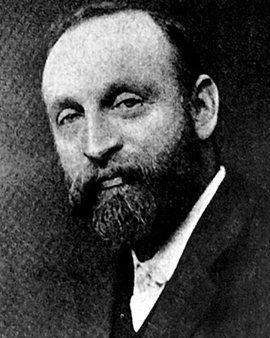The Scottish painter Alexander Mann saw the light of day in Glasgow in 1853. He was the second son of James Mann, a wealthy merchant and art collector. Already in his youth, Mann received painting lessons from James Robert Greenlees. His environment immediately recognized his talent and sent the young man to the Glasgow School of Art, where Greenlees was director. There the ambitious artist further developed his skills. But Glasgow was not to remain the only artistic station. During his career, Mann also moved to Paris and Venice, among other places. He pursued mainly landscape painting and genre painting.
In addition to outdoor painting, Alexander Mann focused on motifs that depicted simple domestic scenes, street illustrations, as well as the respectable life of the peasantry. Views of cities, architectures and park landscapes were also given full attention by the painter. The work 'The End of the Day', shows a fisherman mooring his boat on the beach after work. In the painting 'Shearing Sheep', a shepherd can be seen, who just frees an animal from its wool. Each individual work of art expresses a particular mood. The 'Portrait of Helen Gow' is the best proof of this. In this snapshot, viewers are allowed to catch a glimpse of a lady deeply absorbed in an elegant pose reading a newspaper. Through cleverly staged color gradations, details such as lace on the dress and hairlines can be seen beautifully.
Alexander Mann came to the attention of many well-known institutions. His works were admired and exhibited at the Fine Art Society, the Royal Academy of Arts, the Royal Institute of Oil Painters, the New English Art Club, and the Royal Society of British Artists. Alexander Mann also maintained a studio in Chelsea, where he gave free rein to his creative streak. For a short time, the painter even lived with his family in Tangier. The city is located near the northwestern tip of Morocco. In the last years of his life, however, Alexander Mann was drawn back to England. There he joined the Royal Institute of Oil Painters, which exclusively exhibits oil paintings. An impressive impression from this time is the work 'Aufheben von Silber und Gold'. The oil painting shows a girl who is in a meadow forming a daisy chain. The publication 'Philomene, c. 1890' reveals a somber design. The oil painting depicts a Caucasian woman wrapped in a coat and hat. Although all color components appear extremely dark, the motif arouses curiosity. What is going on inside the woman? What is she thinking? Why did Alexander Mann choose her in particular as an artist's model? In all his works there is a small message, which the painter always conveyed to the public in a remarkable way. Mann died January 26, 1908 in London.
×





.jpg)
.jpg)
.jpg)
.jpg)
.jpg)
.jpg)
.jpg)
.jpg)
.jpg)
.jpg)
.jpg)
.jpg)
.jpg)
.jpg)
.jpg)
.jpg)
.jpg)
.jpg)
.jpg)
.jpg)
.jpg)
.jpg)
.jpg)
.jpg)
.jpg)
.jpg)
.jpg)
.jpg)
.jpg)
.jpg)
.jpg)
.jpg)
.jpg)
.jpg)
.jpg)
.jpg)






